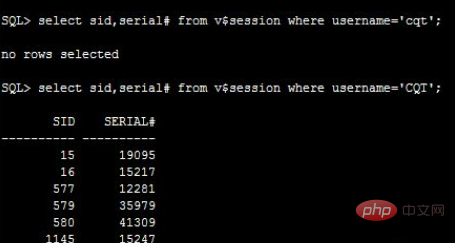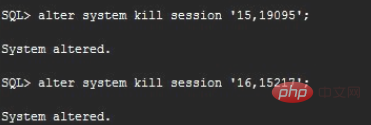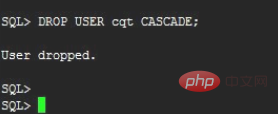What should I do if Oracle cannot delete a user?
Method: 1. Use the "select sid,serial# from v$session where username=''" statement to query session information; 2. Use the "alter system kill session ''" statement to kill the session; 3. Restart delete users.

The operating environment of this tutorial: Windows 10 system, Oracle 11g version, Dell G3 computer.
What should I do if oracle cannot delete the user?
The Oracle database in the test environment needs to be refreshed as the software development version is upgraded, because after the test environment is used for a period of time, the data in it There will be more and more. Sometimes for the convenience of functional testing, the data in the database in the test environment will be inconsistent, which will have a certain impact and interference on the testing of subsequent versions. In order to avoid the above situation, generally all objects under the current database user will be cleared first and then re-created. But to delete all the objects and data under a user, you need to first find out what objects are under the current user, and then delete them. Using the cascade deletion method of deleting users is very simple and convenient, but if the user currently to be deleted is connected, then It cannot be deleted. You need to kill the session first and then delete it.
First you need to use the xshell tool to connect to the oracle database server (the introduction here is in the linux environment, the windows environment is simpler). If the current linux user is not an oracle user, you need to switch to the oracle user. Enter the command, su - oracle to switch

Execute under the oracle user, sqlplus / as sysdba, that is, log in to the database as the administrator sys. Deleting users generally only has the administrator account If you only need to query database tables and data, you only need to log in with a normal account. After connecting, you will be prompted with Connected to: oracle databases and other prompts, and the input prompt that appears becomes SQL>

Then enter the statement to delete the user, DROP USER cqt CASCADE; CASCADE means cascading deletion of all object information under the user. As shown in the figure, ORA-01940 error, the currently connected user cannot be deleted

If you want to continue deleting, you need to first query the user who is currently connected. Session information, then kill it, and then perform the delete operation. The query statement is: select sid,serial# from v$session where username='CQT'; note the difference in case. As shown in the figure, multiple session information connected to the user is queried. It is necessary to kill all the user sessions queried above.

The statement to kill the session is: alter system kill session '15,19095'; For multiple sessions, you can kill them multiple times.

After the above sessions are cleared, execute the command to delete the user again. As shown in the picture, it can be deleted successfully this time. Because this statement adds the cascade delete keyword, all objects and data under this user will be deleted.

The above completes the deletion of users and objects. If it is a database brush operation, you can start to re-create the user and then assign permissions and execute the database script. A new round of version testing is underway.
Notes
Be careful when deleting user objects in cascade to avoid deleting the wrong user or information. You can back up the data before operating.
Recommended tutorial: "Oracle Video Tutorial"
The above is the detailed content of What should I do if Oracle cannot delete a user?. For more information, please follow other related articles on the PHP Chinese website!

Hot AI Tools

Undresser.AI Undress
AI-powered app for creating realistic nude photos

AI Clothes Remover
Online AI tool for removing clothes from photos.

Undress AI Tool
Undress images for free

Clothoff.io
AI clothes remover

Video Face Swap
Swap faces in any video effortlessly with our completely free AI face swap tool!

Hot Article

Hot Tools

Notepad++7.3.1
Easy-to-use and free code editor

SublimeText3 Chinese version
Chinese version, very easy to use

Zend Studio 13.0.1
Powerful PHP integrated development environment

Dreamweaver CS6
Visual web development tools

SublimeText3 Mac version
God-level code editing software (SublimeText3)

Hot Topics
 1386
1386
 52
52
 How to check tablespace size of oracle
Apr 11, 2025 pm 08:15 PM
How to check tablespace size of oracle
Apr 11, 2025 pm 08:15 PM
To query the Oracle tablespace size, follow the following steps: Determine the tablespace name by running the query: SELECT tablespace_name FROM dba_tablespaces; Query the tablespace size by running the query: SELECT sum(bytes) AS total_size, sum(bytes_free) AS available_space, sum(bytes) - sum(bytes_free) AS used_space FROM dba_data_files WHERE tablespace_
 How to view instance name of oracle
Apr 11, 2025 pm 08:18 PM
How to view instance name of oracle
Apr 11, 2025 pm 08:18 PM
There are three ways to view instance names in Oracle: use the "sqlplus" and "select instance_name from v$instance;" commands on the command line. Use the "show instance_name;" command in SQL*Plus. Check environment variables (ORACLE_SID on Linux) through the operating system's Task Manager, Oracle Enterprise Manager, or through the operating system.
 How to encrypt oracle view
Apr 11, 2025 pm 08:30 PM
How to encrypt oracle view
Apr 11, 2025 pm 08:30 PM
Oracle View Encryption allows you to encrypt data in the view, thereby enhancing the security of sensitive information. The steps include: 1) creating the master encryption key (MEk); 2) creating an encrypted view, specifying the view and MEk to be encrypted; 3) authorizing users to access the encrypted view. How encrypted views work: When a user querys for an encrypted view, Oracle uses MEk to decrypt data, ensuring that only authorized users can access readable data.
 How to uninstall Oracle installation failed
Apr 11, 2025 pm 08:24 PM
How to uninstall Oracle installation failed
Apr 11, 2025 pm 08:24 PM
Uninstall method for Oracle installation failure: Close Oracle service, delete Oracle program files and registry keys, uninstall Oracle environment variables, and restart the computer. If the uninstall fails, you can uninstall manually using the Oracle Universal Uninstall Tool.
 How to delete all data from oracle
Apr 11, 2025 pm 08:36 PM
How to delete all data from oracle
Apr 11, 2025 pm 08:36 PM
Deleting all data in Oracle requires the following steps: 1. Establish a connection; 2. Disable foreign key constraints; 3. Delete table data; 4. Submit transactions; 5. Enable foreign key constraints (optional). Be sure to back up the database before execution to prevent data loss.
 How to set up users of oracle
Apr 11, 2025 pm 08:21 PM
How to set up users of oracle
Apr 11, 2025 pm 08:21 PM
To create a user in Oracle, follow these steps: Create a new user using the CREATE USER statement. Grant the necessary permissions using the GRANT statement. Optional: Use the RESOURCE statement to set the quota. Configure other options such as default roles and temporary tablespaces.
 How to solve the problem of closing oracle cursor
Apr 11, 2025 pm 10:18 PM
How to solve the problem of closing oracle cursor
Apr 11, 2025 pm 10:18 PM
The method to solve the Oracle cursor closure problem includes: explicitly closing the cursor using the CLOSE statement. Declare the cursor in the FOR UPDATE clause so that it automatically closes after the scope is ended. Declare the cursor in the USING clause so that it automatically closes when the associated PL/SQL variable is closed. Use exception handling to ensure that the cursor is closed in any exception situation. Use the connection pool to automatically close the cursor. Disable automatic submission and delay cursor closing.
 How to check invalid numbers of oracle
Apr 11, 2025 pm 08:27 PM
How to check invalid numbers of oracle
Apr 11, 2025 pm 08:27 PM
Oracle Invalid numeric errors may be caused by data type mismatch, numeric overflow, data conversion errors, or data corruption. Troubleshooting steps include checking data types, detecting digital overflows, checking data conversions, checking data corruption, and exploring other possible solutions such as configuring the NLS_NUMERIC_CHARACTERS parameter and enabling data verification logging.




